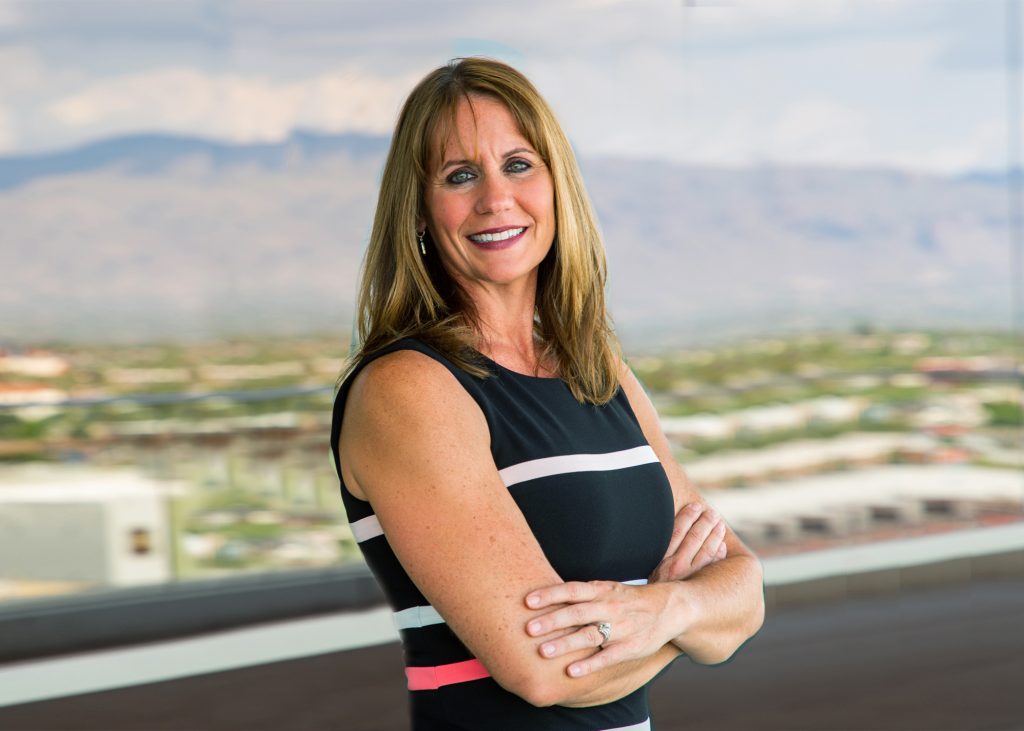Tucson Electric Power (TEP) hired its first female CEO in the company’s 128-year history.
Susan M. Gray, who was a student intern at the utility almost 30 years ago, was named CEO of UNS Energy Corporation and its subsidiaries, including TEP and UniSource Energy Services (UNS), earlier this year.

Now, she’s furthering the company’s most ambitious goal: to generate 70 percent of its energy from renewable energy like solar and wind by 2035. That would reduce the company’s carbon footprint by 80 percent, Gray said.
“It’s aggressive. It’s also reasonable and achievable and it allows us to do it at a pace that we can maintain safe reliable service and maintain affordability,” she said. “If we do it too fast, then we risk affordability.
“Reliability will be a bit of a challenge. But that affordability piece is important.”
Promoted to lead the company in a climate-challenged world
Gray spoke to Chamber Business News about her rise through the rank and file from intern to CEO and what the business community can expect as she leads the company forward in a climate-challenged world.
In addition to renewable energy, Gray said she will continue to promote diversity and inclusion within the traditionally male-dominated energy industry and the Tucson community at large, she said.
“When you look at the pictures of the officers when I started, it was just white men,” she said.
Today’s management team is much more diverse, a credit to company leaders who pushed for it over the past several years, Gray said.
“It’s a tribute to our board, especially Bob Elliot, who was chair for many years. I saw a major shift when Paul Bonavia became our CEO and he really focused on that.”
Hometown daughter follows in father’s, grandfather’s footsteps
Home grown in Tucson, Gray attended the University of Arizona where she enrolled as a biology major. But genetics took over and she was compelled to switch to engineering, following in the footsteps of father and grandfather, both electrical utility engineers.
After doing a student internship in 1994, Gray landed a job at the utility as a system engineer in 1997. For the next 14 years, she worked as an engineer. When she began to pursue leadership roles, she moved up rung by rung every couple of years, wearing a number of hats including vice president of Transmission and Distribution Operations, vice president of Energy Delivery, and chief operating officer.
When she was promoted this year, Gray replaced another home grown CEO, David Hutchens, who was bumped up to president and CEO at Fortis, Inc., the Canadian-based parent company of UNS. Hutchens replaced Barry Perry, who retired.
Biggest challenge in new role: demand for renewables
Gray has been leading the company’s transition as it acquires and builds solar and wind power facilities and retires its coal-based energy resources to meet demand.
More and more companies are asking for renewals, wanting to improve their own emissions record and their public responsibility image with their shareholders. The ability to offer clean-energy solutions is a draw for companies looking to relocate here, Gray said.
Meanwhile, in the race to go renewable, there are some significant challenges, Gray said.
For one, shifting to renewables is much more expensive than many realize. Not only is there an investment in infrastructure and property to build solar plants and wind farms, transmission lines must then be built to traverse hundreds of miles to get to cities like Tucson.
“You can’t build a large solar plant in the center of town. You need transmission to bring resources,” Gray said. “We have a wind plant in New Mexico and we need transmission to get that energy to Arizona.”
That requires building the infrastructure at a reasonable pace to keep costs down, and electric rates affordable for residential and commercial customers.
Another complicating factor is the high cost of energy storage battery systems for renewable energy. Without sufficient storage, reliability will remain a question mark, said Gray.
“The sun doesn’t shine 24/7 and the wind doesn’t blow 24/ 7 although they do tend to have complimentary production curves,” Gray said. “You tend to have more wind at night and solar in the day but there are times where one or either of them are not available so you have to have energy storage.
The demand for grid-scale storage batteries is rising, which should eventually lead to more cost effective options, she said.
“In the long term, energy storage will be critical to providing reliable renewable service,” Gray said.
Working to help businesses transition as well
As commercial customers are requesting more renewables, TEP is working with local businesses and organizations to meet clean energy goals, Gray said. For example, the utility is working with the University of Arizona to provide all the university’s energy through renewable resources.
TEP is also partnering with commercial customers to help them make the decisions about how to best introduce electric vehicles into their daily operations.
“Everybody has a different model. School buses only run twice a day while city buses run all the time. Mail delivery is only in the day, but it’s all day,” Gray said. “We help them evaluate their specific model and determine what their fleet needs to look like, what they’re charging needs to look like, and then we provide incentives to help them get there.”
To learn more about incentives for electric vehicles , including rebates for businesses, visit: TEP electric vehicle programs.
To learn more about solar for businesses, visit: Go solar. To see how much renewable power TEP is delivering to customers right now, go to: TEP Clean Energy Tracker.



 Digging...
Digging...












Add comment